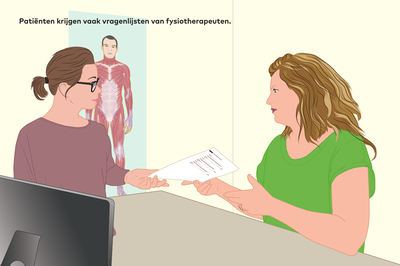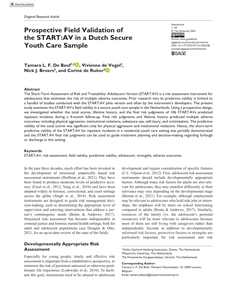The traditional paternalistic approach in health care is increasingly developing towards a patient-centered care (PCC) approach. However, not all patients are able to take advantage of the positive effects of PCC. Inadequate health literacy (HL) is an important limiting factor in the ability of patients to take on an active role and exchange information with their health care provider effectively. A provenly effective approach to improvement of provider-patient interaction and health outcomes is the use of health-related questionnaires. The aim of the research project described within this thesis was to adapt the most frequently-used questionnaire in Dutch physical therapy practice and add information and communication technology to it. A Dutch and Turkish version of the tool called Talking Touch Screen Questionnaire (TTSQ) was developed and evaluated on both usability and validity aspects. The current prototype of the tool does not yet fully solve the problems native and minority patients with low (health) literacy have with completing the adapted questionnaire. Big challenges in future development and testing the TTSQ are the recruitment of vulnerable members of the hard-to-reach native and minority target populations and finding research methods that suit the abilities and needs of these participants. This is expected to be a very challenging, labor- and time-consuming process. On the other hand, having a usable, valid and reliable TTSQ may well save a lot of time and money in both research and clinical practice in the future.
DOCUMENT

Hoofdstuk in Zorgen dat het werkt: werkzame factoren in de zorg voor jeugd. 'Waarom is er zoveel kritiek op de moderne jeugdzorg, die verkokerd, bevoogdend en niet vraaggericht zou zljn? Vaak wordt er gewezen op de gefragmenteerde organisatie, op de niet heldere verdeling van bestuurliike verantwoordelijkheden, op de bureaucratische processen en op de perverse prikkels in het financieringssysteem.Zonder twijfel is er in al die bestuurlijke tuintjes nogal wat onkruid te wieden en kan het hele stelsel eenvoudiger en transparanter. In dit hoofdstuk wordt echter de stelling betrokken dat bestuurlijke reparaties de problemen niet zullen oplossen. Er ligt een dieper, meer zorginhoudelijk problem ten grondslag aan de genoemde problemen.
DOCUMENT

The studies in this thesis aim to increase understanding of the effects of various characteristics of scientific news about a common chronic disease, i.e., diabetes, on the cognitive responses (e.g., emotions, attitudes, intentions) of diabetes patients. The research questions presented in this thesis are guided by the Health Belief Model, a theoretical framework developed to explain and predict healthrelated behaviours based on an individual’s beliefs and attitudes. The model asserts that perceived barriers to a recommended health behavior, advantages of the behavior, self-efficacy in executing the behavior, and disease severity and personal susceptibility to the disease are important predictors of a health behavior. Communication is one of the cues to action (i.e., stimuli) that may trigger the decision-making process relating to accepting a medical or lifestyle recommendation.
DOCUMENT

Boven titel staat vermeld: De symbiose van biologie en technologie. Zowel vanuit het Applied Science onderwijs als vanuit het werkveld kwam er meer vraag om biologische expertise toe te voegen aan het bestaande lectoraat Thin Films & Functional Materials.
DOCUMENT

The Short-Term Assessment of Risk and Treatability: Adolescent Version (START:AV) is a risk assessment instrument for adolescents that estimates the risk of multiple adverse outcomes. Prior research into its predictive validity is limited to a handful of studies conducted with the START:AV pilot version and often by the instrument’s developers. The present study examines the START:AV’s field validity in a secure youth care sample in the Netherlands. Using a prospective design, we investigated whether the total scores, lifetime history, and the final risk judgments of 106 START:AVs predicted inpatient incidents during a 4-month follow-up. Final risk judgments and lifetime history predicted multiple adverse outcomes, including physical aggression, institutional violations, substance use, self-injury, and victimization. The predictive validity of the total scores was significant only for physical aggression and institutional violations. Hence, the short-term predictive validity of the START:AV for inpatient incidents in a residential youth care setting was partially demonstrated and the START:AV final risk judgments can be used to guide treatment planning and decision-making regarding furlough or discharge in this setting.
DOCUMENT

The Integrated Recovery Scale IRS was developed by Dutch National Expertise board for Routine Outcome Monitoring. Recovery is multi dimensional: 1. Symptomatic recovery 2. Physical health, 3. Societal recovery 4. Existential: personal recovery. The validation process and first outcomes of the instrument are described.
MULTIFILE

During the past decades deinstitutionalisation policies have led to a transition from inpatient towards community mental health care. Many European countries implement Assertive Community Treatment (ACT) as an alternative for inpatient care for “difficult to reach” children and adolescents with severe mental illness. ACT is a well-organized low-threshold treatment modality; patients are actively approached in their own environment, and efforts are undertaken to strengthen the patient’s motivation for treatment. The assumption is that ACT may help to avoid psychiatric hospital admissions, enhance cost-effectiveness, stimulate social participation and support, and reduce stigma. ACT has been extensively investigated in adults with severe mental illness and various reviews support its effectiveness in this patient group. However, to date there is no review available regarding the effectiveness of youth-ACT. It is unknown whether youth-ACT is as effective as it is in adults. This review aims to assess the effects of youth-ACT on severity of psychiatric symptoms, general functioning, and psychiatric hospital admissions.
DOCUMENT

Background: Acne vulgaris is a multifaceted skin disorder, affecting more than 85% of young individuals worldwide. Pharmacological therapy is not always desirable because of the development of antibiotic resistance or the potential risk of adverse effects. Non‐pharmacological therapies can be viable alternatives for conventional therapies. However, sufficient evidence‐based support in the efficacy and safety of non‐pharmacological therapies is lacking. Objective: To assess the efficacy and safety of several non‐pharmacological therapies in the treatment of acne vulgaris. Methods: A systematic literature review, including a best‐evidence synthesis, was performed to identify literature. Three electronic databases were accessed and searched for studies published between January 2000 and May 2017. Results: Thirty‐three eligible studies were included in our systematic review. Three main types of non‐pharmacological therapies were identified laser‐ and light‐based therapies, chemical peels and fractional microneedling radiofrequency. The majority of the included studies demonstrated a significant reduction in acne lesions. However, only seven studies had a high methodologic quality. Based on these seven trials, a best‐evidence synthesis was conducted. Strong evidence was found for glycolic acid (10–40%). Moderate evidence was found for amino fruit acid (20–60%), intense pulsed light (400–700 and 870–1200 nm) and the diode laser (1450 nm). Initially, conflicting evidence was found for pulsed dye laser (585–595 nm). The most frequently reported side‐effects for non‐pharmacological therapies included erythema, tolerable pain, purpura, oedema and a few cases of hyperpigmentation, which were in most cases mild and transient. Conclusion: Circumstantial evidence was found for non‐pharmacological therapies in the treatment of acne vulgaris. However, the lack of high methodological quality among included studies prevented us to draw clear conclusions, regarding a stepwise approach. Nevertheless, our systematic review including a best‐evidence synthesis did create order and structure in resulting outcomes in which a first step towards future research is generated.
DOCUMENT

Introduction: Retrospective studies suggest that a rapid initiation of treatment results in a better prognosis for patients in the emergency department. There could be a difference between the actual medication administration time and the documented time in the electronic health record. In this study, the difference between the observed medication administration time and documentation time was investigated. Patient and nurse characteristics were also tested for associations with observed time differences. Methods: In this prospective study, emergency nurses were followed by observers for a total of 3 months. Patient inclusion was divided over 2 time periods. The difference in the observed medication administration time and the corresponding electronic health record documentation time was measured. The association between patient/nurse characteristics and the difference in medication administration and documentation time was tested with a Spearman correlation or biserial correlation test. Results: In 34 observed patients, the median difference in administration and documentation time was 6.0 minutes (interquartile range 2.0-16.0). In 9 (26.5%) patients, the actual time of medication administration differed more than 15 minutes with the electronic health record documentation time. High temperature, lower saturation, oxygen-dependency, and high Modified Early Warning Score were all correlated with an increasing difference between administration and documentation times. Discussion: A difference between administration and documentation times of medication in the emergency department may be common, especially for more acute patients. This could bias, in part, previously reported time-to-treatment measurements from retrospective research designs, which should be kept in mind when outcomes of retrospective time-to-treatment studies are evaluated.
DOCUMENT
